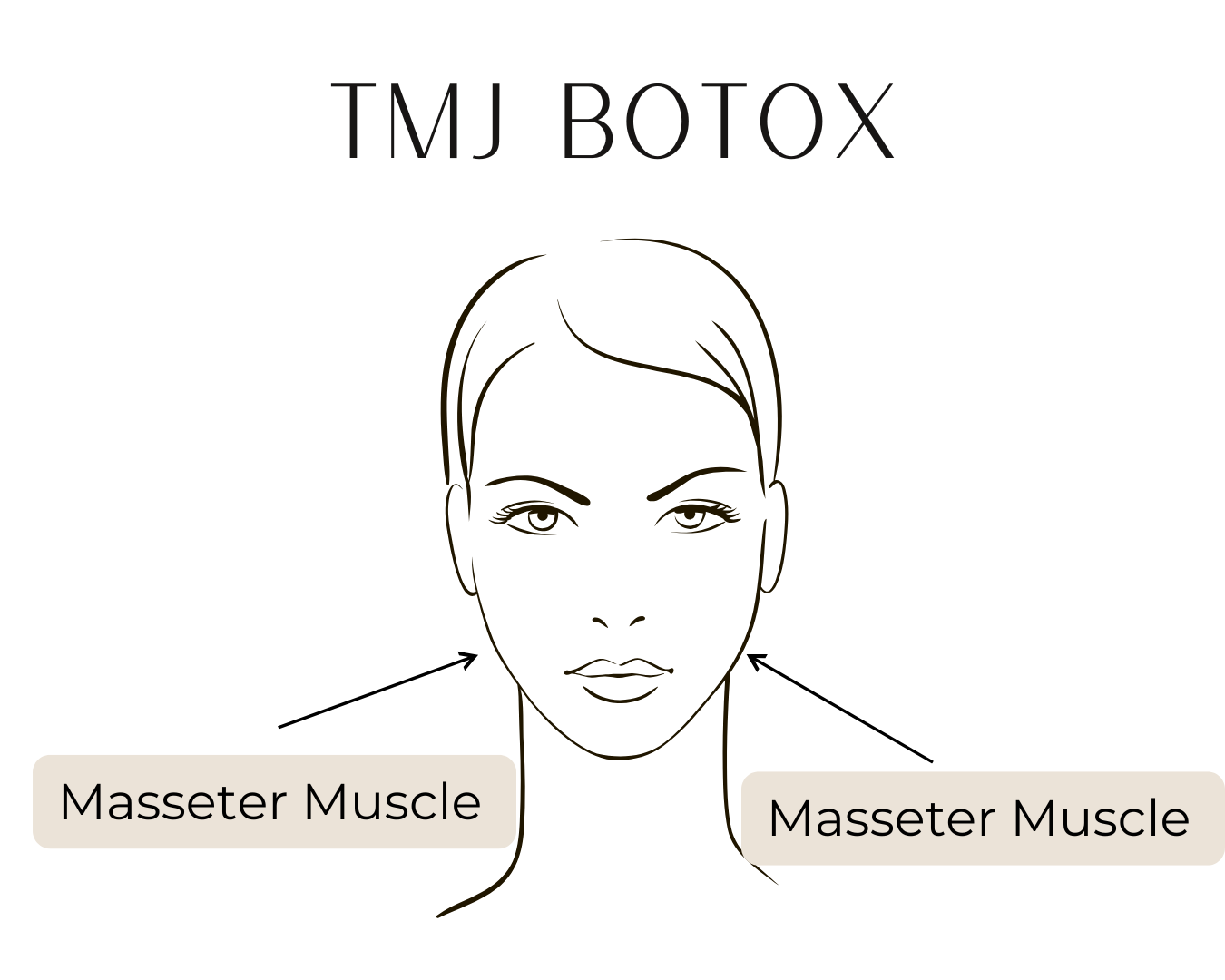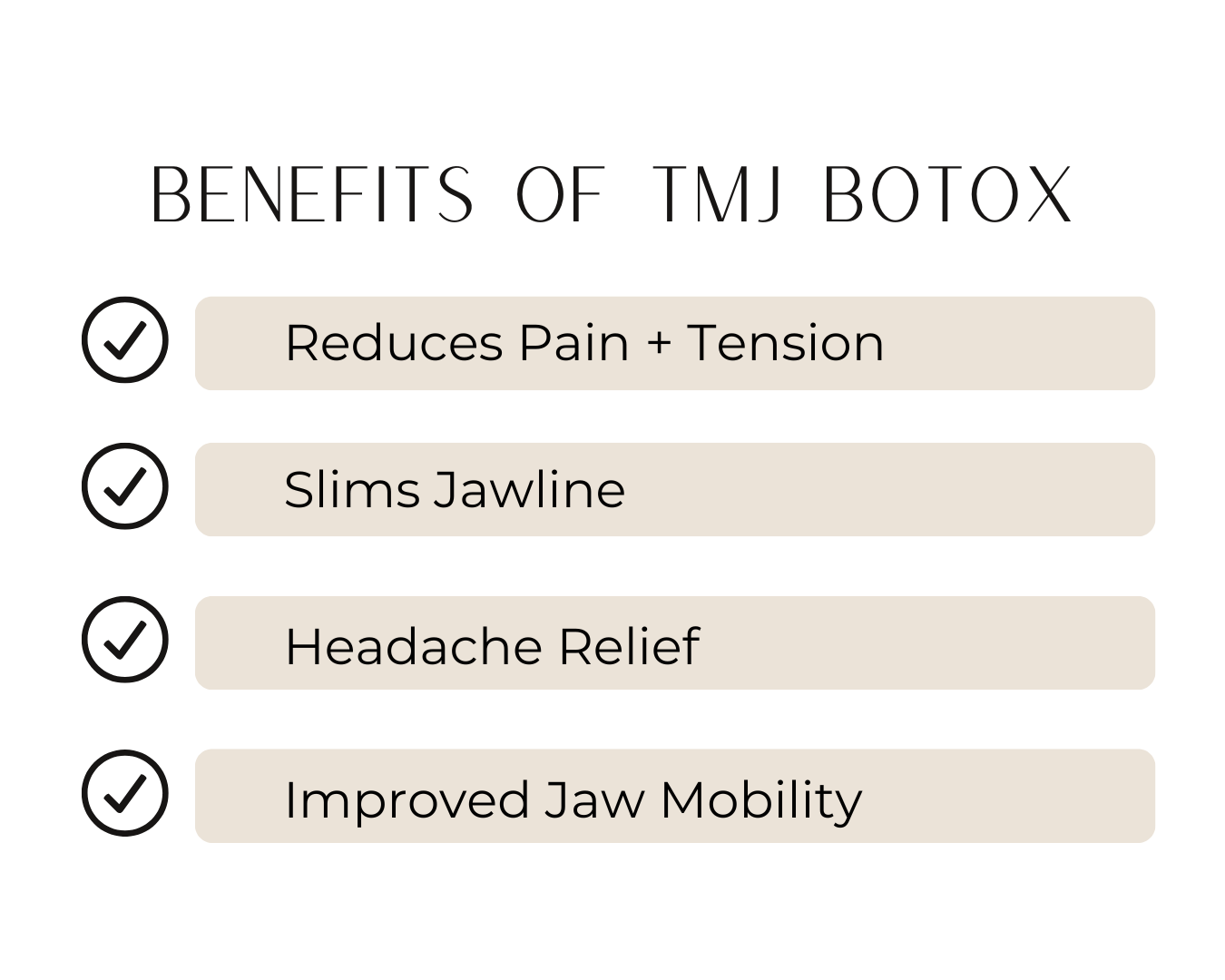Botox for TMJ Guide: What to Expect, Cost, Results, & More
Jaw pain. Tension headaches. Clicking when you chew. If any of these symptoms sound familiar, you could be suffering from a temporomandibular joint disorder (commonly known as TMJ disorder or TMD). The good news? More and more people are finding relief through an innovative and minimally invasive solution: Botox for TMJ.
At Thrive Med Spa in Cincinnati, we specialize in helping clients who struggle with TMJ symptoms by using advanced Botox treatment protocols. In this guide, we’ll explain how botox injections can help relieve pain, what the process looks like, costs, potential side effects, and more.
Key Takeaways
Botox relieves TMJ symptoms by relaxing overactive jaw muscles that cause pain and tension.
Most people notice reduced jaw clenching, headaches, and improved jaw movement within 1–2 weeks.
Botox is a safe, minimally invasive option for long-term management of chronic TMJ disorder.
What Is TMJ and How Does Botox Help?
Understanding TMJ Disorders
The temporomandibular joint (TMJ) connects your lower jaw (mandible) to your skull, just in front of your ears. You rely on this complex jaw joint every time you chew, talk, yawn, or smile.
A temporomandibular joint disorder happens when there is dysfunction in this joint or the surrounding jaw muscles. Common TMJ symptoms include:
Jaw pain or tenderness
Clicking, popping, or locking of the jaw
Difficulty opening or closing your mouth
Facial pain or muscle tightness
Frequent headaches or migraines
Muscle spasms in the face or neck
Earaches or ringing in the ears
TMJ disorders can result from several factors, including:
Teeth grinding (bruxism)
Jaw misalignment
Arthritis
Injury
Stress leading to muscle overuse
How Botox Can Help with TMJ Pain
While many cases of TMJ disorder can improve with physical therapy, oral appliances, or stress management, chronic cases often require additional support. This is where botox injections come in. Botox is a purified form of botulinum toxin, which temporarily relaxes muscles by blocking nerve signals that cause excessive contraction.
When used for TMJ treatment, Botox is injected into the overactive jaw muscles, especially the masseter and temporalis muscles, to:
Relieve pain caused by constant tension
Reduce involuntary teeth grinding and jaw clenching
Minimize facial pain and headaches
Help restore normal jaw function
Botox works by weakening the jaw muscles just enough to prevent damaging overuse, while still allowing you to eat, speak, and function normally.
What to Expect from Botox for TMJ
Treatment Process
At Thrive Med Spa, every TMJ treatment begins with a thorough consultation. Your provider will evaluate your:
Full list of TMJ symptoms
Jaw movement patterns
Medical history
Degree of muscle tension
During treatment:
The skin is cleansed and prepped.
Precise botox injections are made into key facial muscles — typically the masseter muscles, temporalis muscles, and occasionally other muscles like the pterygoids.
Injections are quick and well-tolerated, with most clients describing them as small pinches.
You can return to normal activities the same day, though you’ll want to avoid rubbing the injection sites or doing intense exercise for 24 hours.
How Many Units Are Typically Used?
The amount of botulinum toxin needed depends on factors such as:
Severity of your TMJ disorder
Size and strength of your jaw muscles
How much muscle relaxation is needed to achieve symptom relief
Typical dosing:
Masseter muscles: 15–30 units per side
A typical TMJ botox treatment uses 30–60 total units per session.
Timeline for Relief
Botox for TMJ does not provide immediate relief. Here’s a typical timeline:
3–5 days: Early signs of reduced muscle tension
2 weeks: Peak effect — most clients notice a significant reduction in jaw pain, clenching, and headaches
3–4 months: Results last on average this long, with gradual return of muscle activity over time
For ongoing relief, TMJ botox treatments are usually repeated every 3–4 months, though some clients can extend treatments to 6 months once muscles become better trained.
Benefits of Botox for TMJ
Pain and Tension Relief
The primary goal of Botox treatment for TMJ disorder is to relieve pain caused by hyperactive jaw muscles. By calming the overworked muscles involved in jaw movement, clients often experience improvements in:
Jaw pain and tenderness
Clicking or popping sounds
Stiffness or limited motion
Fewer Headaches and Migraines
Chronic jaw clenching can trigger muscle spasms in the head and neck, contributing to tension headaches or migraines. Many clients find that botox injections significantly reduce the frequency and severity of headaches related to TMJ pain.
Facial Slimming
An added bonus of relaxing the masseter muscles is gradual facial slimming. Enlarged masseters from years of teeth grinding or clenching can give the face a wider, more square appearance. Over time, Botox helps the jaw muscles reduce in size, creating a softer, more tapered facial contour — a highly desired aesthetic outcome for many clients.
How Much Does TMJ Botox Cost?
Cost per Unit
Botox injections for TMJ are priced per unit, typically between $12 and $16 per unit in the Cincinnati area.
Total Cost Estimate
A full TMJ treatment using 30–60 units generally costs $390–$780 per session.
Factors That Influence Cost
Several factors can affect the cost of TMJ botox:
Number of units needed
Provider expertise and experience
Complexity of your case (number of muscles involved)
Location and type of practice (medical spa vs general clinic)
Is It Covered by Insurance?
Insurance coverage for TMJ treatment with botulinum toxin varies:
Some insurance plans will cover it if considered medically necessary after failure of conservative treatments like physical therapy or night guards.
Many plans still classify TMJ botox as "off-label" or elective, meaning you may need to pay out of pocket.
At Thrive, we are happy to provide documentation to help you submit for possible insurance reimbursement.
Potential Side Effects and Safety
Common Side Effects
Botox injections for TMJ pain are generally safe and well-tolerated. Common side effects may include:
Mild bruising or swelling at injection sites
Slight soreness or tenderness in the jaw for a few days
Temporary jaw weakness or reduced bite strength
Rare or Temporary Side Effects
Less common side effects can include:
Temporary asymmetry when smiling
Muscle spasms in adjacent areas
Minor headaches or flu-like symptoms
These effects usually resolve as the Botox treatment wears off naturally.
Is TMJ Botox Safe Long-Term?
Yes, TMJ botox is safe for repeated long-term use. Many clients undergo Botox treatment for years to successfully manage TMJ disorder with no adverse effects. Over time, Botox injections can even help train the jaw muscles to remain more relaxed, potentially reducing the need for frequent treatments.
Is Botox Right for Your TMJ Pain?
When to Consider Botox
Consider TMJ botox if you experience:
Chronic jaw pain or facial pain
Severe teeth grinding or jaw clenching
Headaches associated with TMJ disorder
Limited jaw motion
Failure to improve with other TMJ treatments, such as physical therapy or night guards
Talk to a Qualified Provider
Choosing an experienced injector is key for safe and effective results. At Thrive Med Spa, our providers:
Understand facial anatomy in depth
Use advanced techniques for precise Botox injections
Customize treatment plans to address your unique TMJ symptoms and goals
Learn More about TMJ Botox and More with Thrive
In the Cincinnati Area? Schedule Your Consultation Today
If you’re struggling with TMJ pain or other TMJ symptoms, Botox treatment may be the solution you’ve been seeking. Thrive Med Spa in Cincinnati offers expert, compassionate care for clients dealing with TMJ disorder, as well as a full range of facial aesthetics and wellness treatments.
About Thrive Medical Spa
Located in historic downtown Milford, Thrive Med Spa is Cincinnati’s premier med spa destination for:
TMJ botox
Aesthetic botox injections
Dermal fillers & facial balancing
Advanced skin rejuvenation
Medical-grade skincare
We offer complimentary consultations to help you explore your options and create a personalized treatment plan.
Frequently Asked Questions (FAQs)
Who is a good candidate for TMJ Botox?
Anyone suffering from TMJ symptoms such as jaw pain, facial pain, teeth grinding, or limited jaw mobility may benefit from TMJ botox.
Is Botox covered by insurance for TMJ?
Sometimes, coverage depends on your insurance provider and whether Botox treatment is classified as medically necessary for your TMJ disorder.
How much does TMJ Botox cost?
Typical treatments range from $200 to $650, depending on the number of units needed and treatment complexity.
Is Botox for TMJ painful?
No, the procedure is quick and well-tolerated. Clients typically describe Botox injections as mild pinches.
How quickly does Botox work for TMJ?
Most clients begin noticing relief within 3–5 days, with maximum improvement at 2 weeks.
How long does Botox last for TMJ?
Results generally last 3–4 months. Regular maintenance can provide long-lasting TMJ pain relief.



